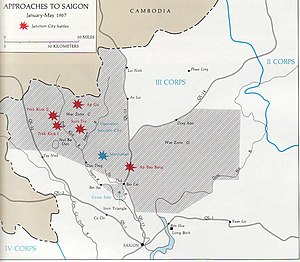Operation Junction City
| Operation Junction City | |||||||
|---|---|---|---|---|---|---|---|
| Part of the Vietnam War | |||||||
 Cedar Falls/Junction City area of operations |
|||||||
|
|||||||
| Belligerents | |||||||
|
|
|
||||||
| Commanders and leaders | |||||||
|
|
|
||||||
| Strength | |||||||
| 30,000 men 240 helicopters 700+ combat vehicles: M48 tank, M113 APC |
Unknown | ||||||
| Casualties and losses | |||||||
|
U.S: 282 killed 1,500 wounded 3 tanks, 21 AFVs, 5 howitzers, 11 trucks destroyed 54 tanks, 86 AFVs, 6 howitzers, 17 trucks damaged South Vietnam: unknown |
U.S reported 2,728 killed | ||||||
Operation Junction City was an 82-day military operation conducted by United States and Republic of Vietnam (RVN or South Vietnam) forces begun on 22 February 1967 during the Vietnam War. It was the largest U.S. airborne operation since Operation Varsity in March 1945, the only major airborne operation of the Vietnam War, and one of the largest U.S. operations of the war. The operation was named after Junction City, Kansas, home of the operation's commanding officer.
The stated aim of the almost three-month engagement involving the equivalent of nearly three U.S. divisions of troops was to locate the elusive 'headquarters' of the Communist uprising in South Vietnam, the COSVN (Central Office of South Vietnam). By some accounts of US analysts at the time, such a headquarters was believed to be almost a "mini-Pentagon," complete with typists, file cabinets, and staff workers possibly guarded by layers of bureaucracy. In truth, after the end of the war, the actual headquarters was revealed by VC archives to be a small and mobile group of people, often sheltering in ad hoc facilities and at one point escaping an errant bombing by some hundreds of meters.
Junction City's grand tactical plan was a "hammer and anvil" tactic, whereupon airborne forces would "flush out" the VietCong headquarters, sending them to retreat against a prepared "anvil" of pre-positioned forces. Total forces earmarked for this operation included most of the 1st Infantry Division and the 25th Infantry Division including the 27th Infantry Regiment and the 196th Light Infantry Brigade and the airborne troops of the 173rd Airborne Brigade and large armored elements of the 11th Armored Cavalry Regiment.
American forces of II Field Force, Vietnam started the operation on 22 February 1967 (while Operation Cedar Falls was winding down), the initial operation was carried out by two infantry divisions, the 1st (commanded by Major General William E. DePuy ) and the 25th (Major General Frederick C. Weyand), who led their forces to the north of the operational area to build the "anvil" on which, according to the American plans, the forces of the Viet Cong 9th Division would be crushed. At the same time the movement of infantry (eight battalions with 249 helicopters), took place on the same day including the launch of 845 paratroopers (the only large-scale jump carried out during the Vietnam War and the largest since Operation Tomahawk of the Korean War), an airborne regiment of the 173 Airborne Brigade, which went into action west of the deployment of the 1st and the 25th Infantry Divisions.
...
Wikipedia
